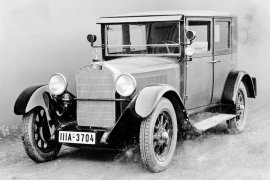Segment: Lower Premium
Production years: 1926, 1927, 1928
 11 Photos
11 PhotosAfter the merger between Daimler-Motoren-Gesselschaft (DMG) and Benz & Cie., a new brand was formed by the name of Mercedes-Benz, and the first production model was the 1926 8/38.
These two companies struggled to decide whether to go for affordable or luxurious vehicles. Each of them had a point, but the market was the final decider. So, after a long gestation period, the carmaker introduced the 8/38 (W02) on the market in 1926. The prototype for this vehicle was the W01, but it never reached production. The nameplate suggested the engine had 38 PS (37.5 hp), while the 8 was for displacement-based fiscal power. In 1928, the car also got the Typ 200 nameplate added, where that number stood for the two-liter engine.
Mercedes-Benz produced this affordable vehicle in large numbers. Its bodywork was simple, with squared lines and flat panels. The design was similar to most other vehicles from that era. Moreover, its radiator was simple but with an arched line at the top. A feature that followed for decades after it was the horizontal bar that connected the arched wheel fenders where the automaker installed the headlights. From its profile, the car boasted a set of multi-spoke wooden wheels (artillery wheels), and the engine compartment's side lid sported louvers that helped to cool the engine. Thanks to the rear-hinged rear doors, access in the back was easy, while at the front were regular ones. Behind the vehicle, the automaker placed the spare wheel.
The cabin wasn't luxurious but well-built and had decent materials. Furthermore, its four-spoke steering wheel, wooden dashboard, and side windows were very appreciated at those times when many vehicles didn't even sport a roof.
DMG developed an inline-six powerplant for this vehicle, and while it wasn't a masterpiece, it was sturdy. In addition, it served as a base for future developments, with engine displacements of up to three liters.
MERCEDES BENZ 8/38 Typ 200 (W02) 1926, 1927, 1928
- 2.0
MERCEDES BENZ 8/38 Typ 200 (W02)
2.0
ENGINE SPECS - 2.0 | |
|---|---|
| Cylinders: | L6 |
| Displacement: | 1988 cm3 |
| Power: | 28 KW @ 3400 RPM 38 HP @ 3400 RPM 38 BHP @ 3400 RPM |
| Torque: | 72 lb-ft @ 1400 RPM 98 Nm @ 1400 RPM |
| Fuel System: | Carburetor |
| Fuel: | Gasoline |
PERFORMANCE SPECS | |
|---|---|
| Top Speed: | 47 mph (76 km/h) |
TRANSMISSION SPECS | |
|---|---|
| Drive Type: | Rear Wheel Drive |
| Gearbox: | Manual, 3 Speed |
BRAKES SPECS | |
|---|---|
| Front: | Drums |
| Rear: | Drums |
TIRES SPECS | |
|---|---|
| Tire Size: | 30 X 5.25 |
DIMENSIONS | |
|---|---|
| Length: | 159.8 in (4059 mm) |
| Width: | 66.1 in (1679 mm) |
| Height: | 70.9 in (1801 mm) |
| Front/rear Track: | 56.1/56.1 in (1,425/1,425 mm) |
| Wheelbase: | 110.6 in (2809 mm) |
WEIGHT SPECS | |
|---|---|
| Unladen Weight: | 2535 lbs (1150 kg) |
| Gross Weight Limit: | 4078 lbs (1850 kg) |
FUEL ECONOMY (NEDC) | |
|---|---|
| Combined: | 15.7 mpg US (15 L/100Km) |
| CO2 Emissions: | 357 g/km |










